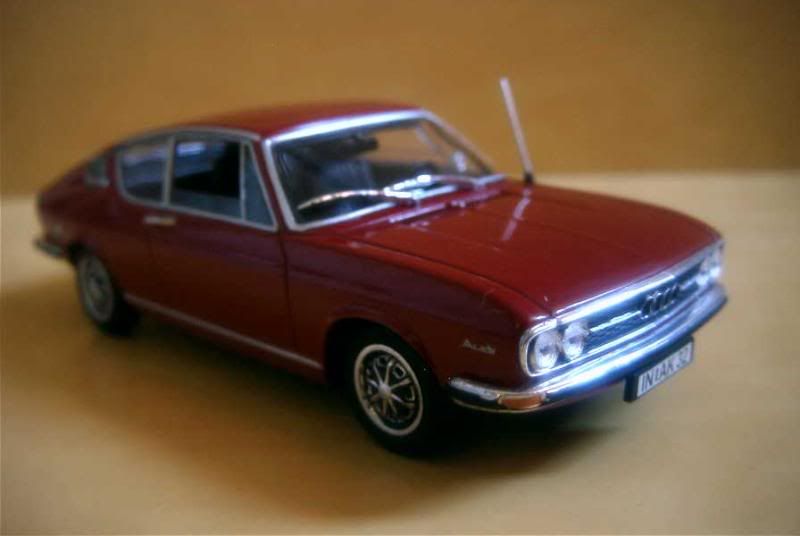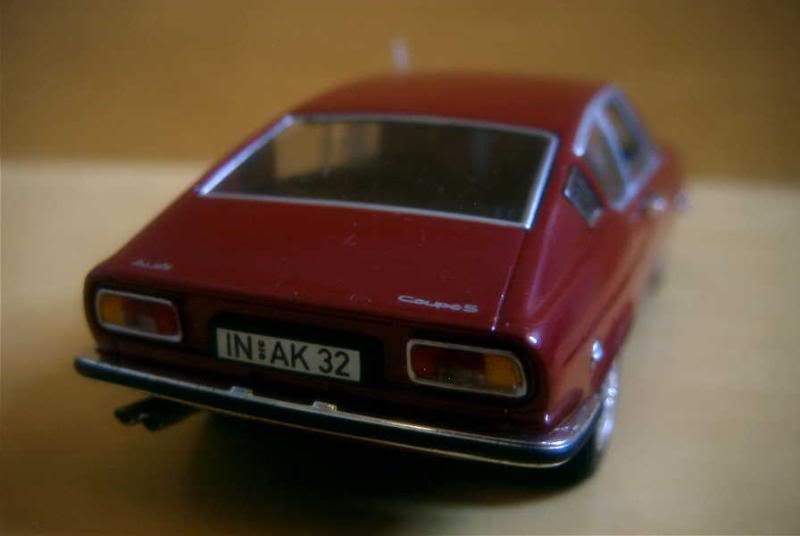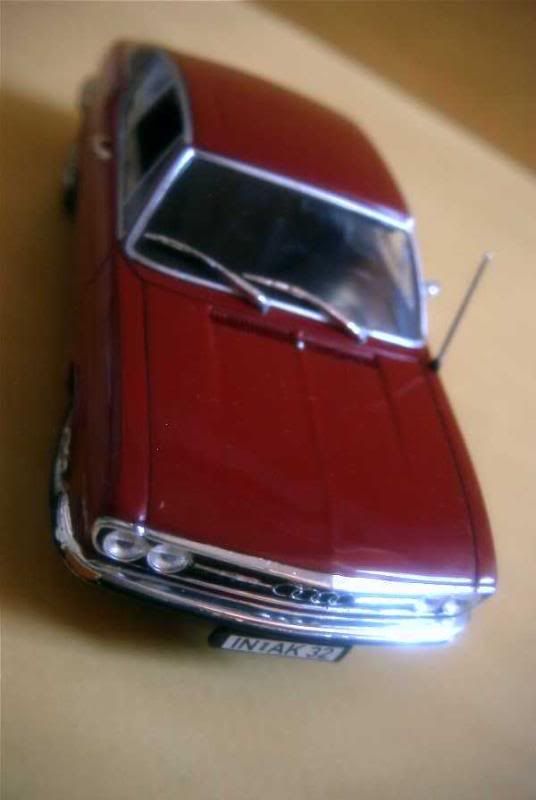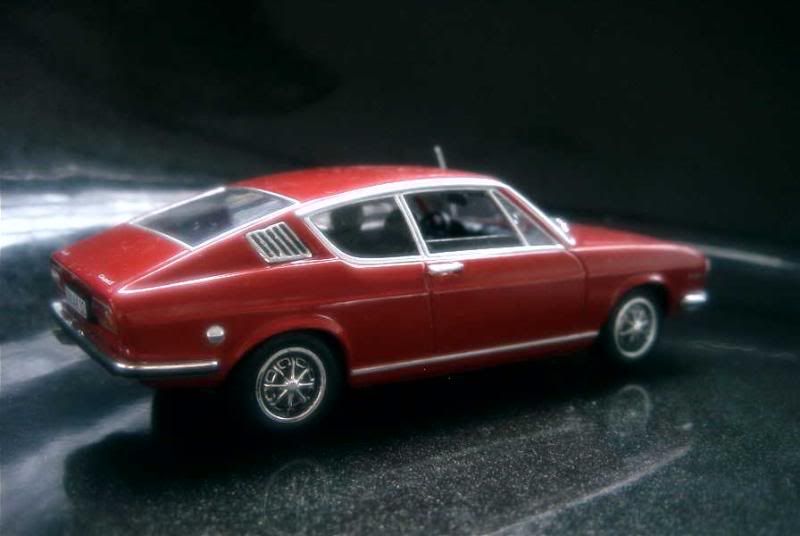A little history
When Volkswagen purchased Auto Union in 1965, it didn’t have any plan for the old brand further than renaming it Audi. Some employees at Ingolstadt couldn’t accept the programmed death of the company they had worked for for so many years, and started to design the new car that would justify Audi’s continuation. Volkswagen having forbidden the study of any new model at Audi’s, all their work had to be kept secret. When one prototype was ready came the great jeopardy: introducing Volkswagen’s management to Audi’s project. Against all odds, production of the new car was accepted.
Audi’s new flagship was the 100 model, which was introduced in November 1968 as a large four-door saloon, fitted with a 1.8-litre four driving the front wheels, as was the company’s old tradition. Good performances and nice looks made the car particularly attractive, though its price didn’t put it within reach of the common motorist. Nevertheless production rates immediately indicated that Audi had just launched one of its most successful models ever. Choice was extended by steps with the introductions of a two-door saloon for model year 1970, followed by a splendid fastback coupe one year later. An automatic gearbox soon became available. This first generation Audi 100, known internally as the C1, was built until 1976.
Having encountered such a success the 100 had to be maintained in Audi’s range, capping the newly-launched 80 and 50 models. The new car which Audi unveiled in 1976, the C2, was certainly more utilitarian than its predecessor with its plainer look and the disappearance of a coupe version. Instead, a hatchback saloon, the “Avant”, appeared for model year 1978. An upscale 200 was also part of the range; it introduced a potent 2.1-litre turbocharged engine in 1979, soon to be found under the bonnet of the revolutionary Quattro coupe. The use of an inline five is worth noticeable too – only Mercedes-Benz had fitted such an engine to its production vehicles up to then. German production of the C2 was stopped in 1982, though it was maintained for two more years in some parts of the world.
After the C2 was abandoned, Audi introduced a third-generation 100. This C3 was years ahead of design trends, featuring the wedged, aerodynamic look that would only become the standard of the industry ten to fifteen years later. Divided again between the mass-produced 100 and the more exclusive 200, all C3s now had four doors, the slow-selling two-door saloon being dropped. The Avant name was maintained, but was now attached to an estate – certainly the most elegant and sporty in its class – rather than a fastback. Interestingly, though the 100/200s were rather large cars to European standards, they never received an engine larger than their trusted inline five… until the introduction in 1988 of an Audi V8, roughly similar to the C3 but in fact heavily modified.
With its very elegant design, its building quality and the economy provided by its excellent aerodynamics, the sales of the C3 were very high, particularly for an automobile of its class. A much deserved European Car of the Year award in 1983 certainly didn’t hurt, either. This success justified that the C3 was maintained in production for nine straight years. The car was retired in 1991, but its design was still so modern then that it isn’t much surprise that it was resurrected: production soon restarted in China at Hongqi’s, alongside the state limousines this factory made itself known for.
As for the European Audi 100/200, it saw a fourth iteration from 1991 on, called C4. This car was nonetheless renamed A6 four years later, so we’ll discuss about it separately.
About the model
Model: Audi 100 Coupé S
Year: 1970
Maker: Minichamps
Scale: 1/43
Distributed by: Minichamps, limited edition - 1,200 pieces
Acquired: brand new, in May 2006, in Manila, Philippines
Minichamps is the logical choice for a vintage German car. It doesn’t disappoint, offering several models of Audi 100s, including this nicely crafted C1 coupe to which I’d give 14/20. As a personal note I should add that this fastback coupe, despite having been built in relatively large quantities (more than thirty thousand copies), doesn’t seem to have been widely exported out of Germany – I just remember seeing one in my whole life.




When Volkswagen purchased Auto Union in 1965, it didn’t have any plan for the old brand further than renaming it Audi. Some employees at Ingolstadt couldn’t accept the programmed death of the company they had worked for for so many years, and started to design the new car that would justify Audi’s continuation. Volkswagen having forbidden the study of any new model at Audi’s, all their work had to be kept secret. When one prototype was ready came the great jeopardy: introducing Volkswagen’s management to Audi’s project. Against all odds, production of the new car was accepted.
Audi’s new flagship was the 100 model, which was introduced in November 1968 as a large four-door saloon, fitted with a 1.8-litre four driving the front wheels, as was the company’s old tradition. Good performances and nice looks made the car particularly attractive, though its price didn’t put it within reach of the common motorist. Nevertheless production rates immediately indicated that Audi had just launched one of its most successful models ever. Choice was extended by steps with the introductions of a two-door saloon for model year 1970, followed by a splendid fastback coupe one year later. An automatic gearbox soon became available. This first generation Audi 100, known internally as the C1, was built until 1976.
Having encountered such a success the 100 had to be maintained in Audi’s range, capping the newly-launched 80 and 50 models. The new car which Audi unveiled in 1976, the C2, was certainly more utilitarian than its predecessor with its plainer look and the disappearance of a coupe version. Instead, a hatchback saloon, the “Avant”, appeared for model year 1978. An upscale 200 was also part of the range; it introduced a potent 2.1-litre turbocharged engine in 1979, soon to be found under the bonnet of the revolutionary Quattro coupe. The use of an inline five is worth noticeable too – only Mercedes-Benz had fitted such an engine to its production vehicles up to then. German production of the C2 was stopped in 1982, though it was maintained for two more years in some parts of the world.
After the C2 was abandoned, Audi introduced a third-generation 100. This C3 was years ahead of design trends, featuring the wedged, aerodynamic look that would only become the standard of the industry ten to fifteen years later. Divided again between the mass-produced 100 and the more exclusive 200, all C3s now had four doors, the slow-selling two-door saloon being dropped. The Avant name was maintained, but was now attached to an estate – certainly the most elegant and sporty in its class – rather than a fastback. Interestingly, though the 100/200s were rather large cars to European standards, they never received an engine larger than their trusted inline five… until the introduction in 1988 of an Audi V8, roughly similar to the C3 but in fact heavily modified.
With its very elegant design, its building quality and the economy provided by its excellent aerodynamics, the sales of the C3 were very high, particularly for an automobile of its class. A much deserved European Car of the Year award in 1983 certainly didn’t hurt, either. This success justified that the C3 was maintained in production for nine straight years. The car was retired in 1991, but its design was still so modern then that it isn’t much surprise that it was resurrected: production soon restarted in China at Hongqi’s, alongside the state limousines this factory made itself known for.
As for the European Audi 100/200, it saw a fourth iteration from 1991 on, called C4. This car was nonetheless renamed A6 four years later, so we’ll discuss about it separately.
About the model
Model: Audi 100 Coupé S
Year: 1970
Maker: Minichamps
Scale: 1/43
Distributed by: Minichamps, limited edition - 1,200 pieces
Acquired: brand new, in May 2006, in Manila, Philippines
Minichamps is the logical choice for a vintage German car. It doesn’t disappoint, offering several models of Audi 100s, including this nicely crafted C1 coupe to which I’d give 14/20. As a personal note I should add that this fastback coupe, despite having been built in relatively large quantities (more than thirty thousand copies), doesn’t seem to have been widely exported out of Germany – I just remember seeing one in my whole life.







No comments:
Post a Comment